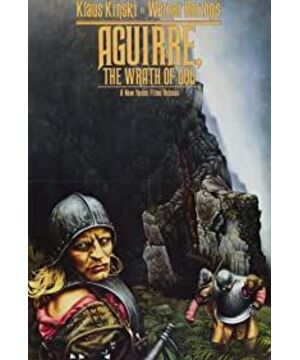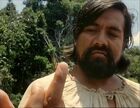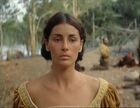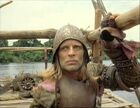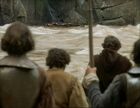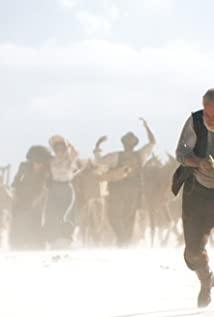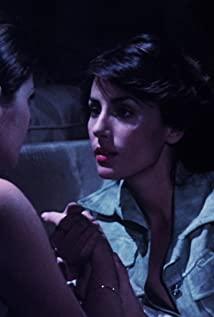Aguirre, the wrath of God
Aguirre, the Wrath of God, 1973
"God gave up before he finished building this river."
The Indian solemnly said this to the Spaniard who captured him. This Spanish expedition followed the Amazon River in search of the fabled golden city of El Dorado, all the way through hardships, and at this moment most of the deaths and injuries have occurred. The missionary on the expedition handed the Indian a bible and told him that it was "the word of God", so he held the bible to his ear but heard nothing. There was a small gold pendant hanging from his neck. The Spaniard pulled it off and held it in front of his eyes fascinated. Hope rekindled in his heart: they have walked so long, and now they are finally going to find the city of gold. They shouted at the Indians: "Where is the Golden City?" The slave translated the Spanish words to the Indians, and he just waved at the river in general. The Golden City is still far away, always far away.
Werner Herzog's "Aguirre, God's Wrath" is an unforgettable nightmare about the Spanish conqueror Gonzalo Pizarro (1502-1548) Under the temptation of legends, between 1560 and 1561, 1 led a team of men and horses to go deep into the rainforest of Peru to find the lost Eldorado, which was almost completely annihilated in the end. The opening shots of the film showed a shocking picture: between the peaks covered by clouds and mist, a long line of people descended along a steep mountain road into a deep valley. All the men in the team wore steel helmets and breastplates, while their women sat in sedan chairs, well-shielded. Such a dress is only suitable for attending the palace event, not suitable for trekking in the tropical rain forest.
1 Historically, Gonzalo Pizarro’s expedition actually took place between 1541 and 1542. "Aguirre" delayed the time by twenty years, perhaps to imply that the film is fictitious.
The soundtrack of "Aguirre" is both religious and human, as if there is something indescribable, which not only makes the audience unforgettable, but also sets the tone of the whole film. This soundtrack was composed by Florian Fricke. His band "Popoulou" (the name is derived from the legend of the Mayan civilization about the origin of all things) has been a part of Herzog’s many films Soundtrack. Herzog told me about the opening part of "Aguirre": "At that time we used a special instrument, we called it the'choir organ'. There are thirty-six different tapes in the organ. One roll is rolled parallel next to another. All the tapes are played at the same time, and the instrument can be played through a keyboard like an organ. The sound is like a vocal chorus, but at the same time it is very mechanical and very weird."
I especially emphasize the soundtrack of "Aguirre" because sound effects are an indispensable part of Herzog's films. The story he tells is simple and straightforward at the beginning, but the result is unpredictable, and the effect is immeasurable. After his film is over, it can still arouse a special emotion in our hearts, whether it is sacred or empty. I believe that Herzog hopes that the audience can stay out of the time of the movie when watching his film, and witness as a bystander how the infinite power of God can completely destroy human ideals and dreams, and feel deeply for it. sorrow.
If the soundtrack is critical to the film "Aguirre, God's Wrath," then the face of Klaus Kinski has the same meaning. He has a pair of panicking blue eyes, and his lips are thick and wide, which should have looked very sensual, but because he always grinned fiercely, he looked crazy instead. He played the most determined role in the Spanish expedition in "Aguirre". Herzog once told me that the first time he met Kinsky was in Germany, when he was still a young man. "I knew at the time that I was destined to make movies in my life, and Kinsky was destined to act in my movies."
Because Pizarro was worried that his expedition was purely stupid, he chose a vanguard and gave them a week to explore the upper reaches of the river. Pizarro said, if they get nothing, they will give up the expedition. This team is led by Noble Don Pedro de Usaya, with Aguirre (Jinsky) as the deputy captain. In addition to ordinary soldiers and slaves, there is also a priest in the team named Gaspard Carvajal. The members of the squad also include aristocratic but stupid Fernando de Guzman, Usaya's wife Flores, Aguirre's daughter Ines1, and a black slave named O'Kero , He once said sadly to a female family member: "I was born a prince, and most people are not allowed to even look at me, but now I wear a cast." 2
1 In the film, Usaya's wife is named Inez, and Mian Aguir's daughter is named Flores. The author confuses the names of these two characters.
2 In the film, it is Baltasha, the Indian guide of the expedition, who said this passage, not O'Kero. The author may have made a mistake here.
Herzog neither speeded up the expedition's itinerary, nor deliberately fabricated any suspenseful plots or action scenes to join it. The first thing we as spectators feel is how wide the river is on this group of Spaniards, and how wide the surrounding forest is, as if it is endless, rising from the water of a thousand rivers, flooding the river bank, they even have no place to settle. Not long after the expedition set off, a crisis was encountered. A raft was caught in a whirlpool. The slaves shook their oars frantically, but the raft couldn't move. Herzog’s handling of this episode is worth noting. He fixed the camera on the other side of the river and shot the raft in danger across the river, so that the plight of those on the raft seemed remote and helpless. Aguirre sneered at all proposals to rescue the trapped teammates, but Captain Usaya had sent a group of people to try to assist them from the other side of the river.
At dawn, the raft was still floating in place, but all the people on the raft were dead. How did they die? Different people have different opinions on this issue. Importantly, this plot indicates that death is the ultimate fate of the entire expedition, and no one can escape. Captain Usaya was locked up, and Guzman was selected as the new captain under Aguir's arrangement. It didn't take long for the two men to lose their lives. When Guzman was dying, he was greedily chewing fish and fruit as the "emperor", but his men could only divide a few corns into each. When a horse went crazy, he ordered the horse to be driven off the boat, which aroused strong dissatisfaction among the people. They secretly argued that the horse could feed everyone for a week, but he had thrown it away in vain. Later, someone discovered Guzman's body.
Aguirre launched a reign of terror on the ship. He always slanted around on the raft, his weird gait was as if he had one knee that couldn't bend. His eyes were crazy. Aguirre heard that someone in the team was planning to escape privately, and immediately drew a knife and chopped off that person's head. His movements were as fast as lightning. When the chopped head flew out, his mouth was still talking. The film rarely shows death head-on. The occasional scenes of death are also quick and quiet. For example, arrows fly silently from the jungle and shoot into the neck and back of the Spaniard. The last scene of the film is one of the most impressive shots of all the movies I have ever watched. In the picture, Aguirre is standing alone on a raft, still dreaming of his impending empire, surrounded by him. The corpse, there are hundreds of little monkeys screaming.
The shooting process of "Aguirre" has become a legend in the film industry. The German director Herzog believes in the "magic of places" and personally led actors and photography teams into remote jungle areas, where not only the fever is raging, but also There is a shortage of food, and there is even a possibility of starvation. It is said that Herzog used a gun to force Kinsky to continue performing, but Kinsky himself denied this in his autobiography, and added grimly that he was the only one in the team with a gun. The actors, staff, and cameras are all placed on the raft we saw in the film. Herzog once told me, "I haven't thought about the dialogue until ten minutes before the filming of a scene." This often happens.
The film does not rely on dialogue to promote the plot, nor does it even rely on characters other than Aguirre. The image of Aguirre is largely shaped by Kinsky’s facial language and body language. Dialogue is not the most important thing. part. In my opinion, the story of "Aguirre" and Herzog's other films express the same theme: people are obsessed with the dream of success, and even go through fire and water for it, so they committed it. The great sin of "prudence" was eventually crushed to pieces by the ruthless God. "Aguirre" is reminiscent of another Herzog documentary. The protagonist Steiner loves ski jumping and longs to fly in the air forever. Due to his skill, he even crossed the landing area and hit trees or rocks. Danger.
Werner Herzog is one of the modern directors who loves fantasy and is obsessed with grand themes. In addition to movies, he has also directed many operas. He is unwilling to use complicated plots to hang people's appetite, and he is unwilling to use funny dialogues to make fun of people. He wants to shock us audiences and lead us into a lofty state. In my opinion, only a few of the modern movies such as "2001: A Space Odyssey" and "Apocalypse Now" have the bold fantasy of Herzog. Among the contemporary active film directors, only Oliver Stone has the consciousness and courage of a savior like Herzog. The two men talked about their work with a saintly madness. People like them were dismissive of success in the general sense, because they were pursuing true greatness.
Herzog’s other film "Fitzcarraldo" (Fitzcarraldo, 1982) can be seen as a companion to "Aguirre". This film is also starring Jinsky, also shot in the rain forest, and also tells about An impossible task: In order to move a steamer from one river to another, a man wants to drag the ship over the land between the two rivers. In order to shoot this film, Herzog ignored the serious warnings of the engineers and risked breaking the rope and cutting everyone at the waist. He really dragged a genuine ship across the entire land, which fully demonstrated his consistent style. . Les Blank (Les Blank) made the filming process of "A Boat on the Land" into a documentary called "Burden of Dreams" (1982). The content of this documentary is like that of "A Boat on the Land" The story is as tragic as it is enough to break the viewer's heart.
(Translated by Yin Yan)
View more about Aguirre, the Wrath of God reviews


